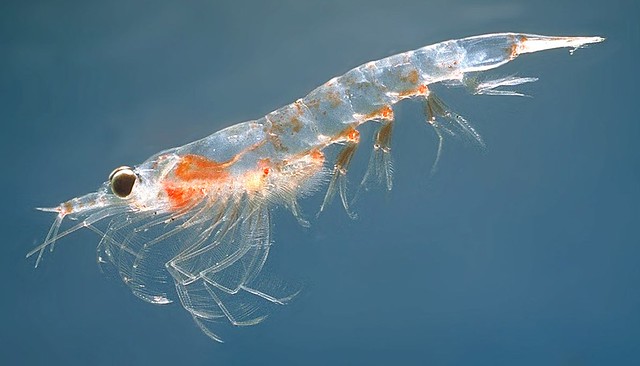http://e-info.org.tw/node/117813
海洋酸化 南極磷蝦餓肚子 研究:食物鏈恐全面瓦解
文字大小
4587 2 Share2

摘譯自2016年8月9日ENS澳洲,坎培拉報導;姜唯編譯;蔡麗伶審校
科學家去(2015)年曾以實驗結果推測,海洋酸化可能成為破壞海洋食物鏈的元兇。如今南極的科學研究站發現,海洋中的二氧化碳濃度飆高,當地浮游植物的數量和體型都顯著縮水,而浮游植物是南極磷蝦的主食,磷蝦又為許多南極動物的主食,恐怕將連帶影響南極的生態系統。

磷蝦只吃大於0.006 mm的浮游植物。身為許多動物的主食,磷蝦若受到任何影響都會有嚴重的連鎖效應。圖片來源:wikipedia Øystein Paulsen (CC BY-SA 3.0)。
磷蝦是極小的甲殼類動物,是南極生態系統的關鍵物種,也是海豹、鯨、魚類、魷魚、企鵝和海鳥等許多動物的主食。
澳洲南極署首席調查員,海洋微生物生態學博士戴維森(Andrew Davidson)和其研究團隊,多年研究有關海洋酸化對菌落、浮游植物和原蟲的影響。
海洋酸化是指地球海洋因為持續從大氣吸收二氧化碳,導致pH值不斷下降的現象。1700年代起,工業和農業活動使大氣中的二氧化碳增加。海洋每年從大氣中吸收1/4的多餘二氧化碳,因此當大氣中二氧化碳增加,海洋中二氧化碳含量也隨之增加。
 |
| 浮游植物等海洋微生物雖然很小,但數量非常龐大,是南極食物網的唯一植物能量來源。攝影:G. Fahnenstiel。圖片來源:NOAA (CC BY-SA 2.0) |
研究人員在南極東岸戴維斯研究站進行研究,並將研究發表於《海洋生態進度系列》期刊。
研究結果顯示,浮游植物會隨著海中二氧化碳含量變化,出現快速而顯著的改變。
「我們發現浮游植物接觸到約750ppm的二氧化碳,數量和體型都會顯著縮水。大於0.02 mm的浮游植物數量下降,小於0.005 mm的浮游植物增加。」戴維森說。而「浮游植物等海洋微生物雖然很小,但數量非常龐大,是南極食物鏈的唯一植物能量來源。此外,浮游植物也有調節全球氣候的功能。」
「磷蝦只吃大於0.006 mm的浮游植物。身為許多動物的主食,磷蝦若受到任何影響都會有嚴重的連鎖效應。」戴維森說。
此外戴維森也警告,「大型浮游植物減少也會影響全球的碳循環。浮游植物會吸收二氧化碳行光合作用,尤其是大型浮游植物,會將吸收的碳帶往海底,調節地球表面的溫室氣體的濃度。」
「小型浮游植物細胞下沉得較慢,而且比較容易被細菌和原蟲攝食,使二氧化碳重新被排出到大氣中。」戴維森解釋。
Acid Oceans Killing Antarctic Food Web
CANBERRA, Australia, August 9, 2016 (ENS)
An acidifying ocean absorbing too much carbon dioxide from the atmosphere could have a major impact on phytoplankton – the staple diet of krill – with serious repercussions for the entire Antarctic ecosystem, scientists from the Australian Antarctic Division have found.
Krill are tiny crustaceans. They are the keystone species of the Antarctic ecosystem and the staple diet of many animals, including seals, whales, fish, squid, penguins and flying seabirds.
Krill are tiny crustaceans. They are the keystone species of the Antarctic ecosystem and the staple diet of many animals, including seals, whales, fish, squid, penguins and flying seabirds.
Chief investigator marine microbial ecologist Dr. Andrew Davidson and his team of researchers issued that warning today after years of studying the effects of ocean acidification on communities of bacteria, phytoplankton and protozoa.
Ocean acidification is the ongoing decrease in the pH of the Earth’s oceans, caused by the increasing uptake of carbon dioxide (CO2) from the atmosphere. See an infographic illustrating the process.
Ocean acidification is the ongoing decrease in the pH of the Earth’s oceans, caused by the increasing uptake of carbon dioxide (CO2) from the atmosphere. See an infographic illustrating the process.
Since the mid-1700s, industrial and agricultural activities have increased the amount of CO2 in the atmosphere. The ocean absorbs about a quarter of the CO2 humans release into the atmosphere every year, so as atmospheric CO2 levels increase, so do the levels in the ocean.
The experiment was conducted at Davis research station on Antarctica’s east coast.
The experiment was conducted at Davis research station on Antarctica’s east coast.
The results, published in the “Marine Ecology Progress Series,” show a rapid and significant change for phytoplankton when it was exposed to the carbon dioxide (CO2) levels predicted in seawater by the end of the century.
“We found that phytoplankton decrease in number and size when exposed to levels of carbon dioxide (CO2) above approximately 750 parts per million (ppm),” Davidson said.
“We found that phytoplankton decrease in number and size when exposed to levels of carbon dioxide (CO2) above approximately 750 parts per million (ppm),” Davidson said.
“The abundance of large phytoplankton bigger than 0.02 mm decline, and we saw an increase in phytoplankton smaller than 0.005 mm,” he said.
Davidson explained that marine microbes such as phytoplankton may be very small but they are vastly abundant, the sole source of plant material for the Antarctic food web. They also help mediate the global climate.
Davidson explained that marine microbes such as phytoplankton may be very small but they are vastly abundant, the sole source of plant material for the Antarctic food web. They also help mediate the global climate.
“Krill only graze on phytoplankton bigger than 0.006 mm, and as the staple diet of many animals, any impact on krill will have serious repercussions,” Davidson warned.
Dr. Davidson said a decrease in larger phytoplankton would also impact the global carbon cycle.
Dr. Davidson said a decrease in larger phytoplankton would also impact the global carbon cycle.
“Phytoplankton incorporate CO2 into their cells during photosynthesis and the cells, usually the large ones, sink to the ocean carrying the carbon with them,” he said.
By storing CO2 in the depths of the ocean, phytoplankton help mediate the concentration of the greenhouse gas in the Earth’s atmosphere.
By storing CO2 in the depths of the ocean, phytoplankton help mediate the concentration of the greenhouse gas in the Earth’s atmosphere.
“Smaller phytoplankton cells will sink slower and often the smaller cells will be consumed by protozoa and bacteria – which release the CO2 back into the atmosphere,” Davidson said.
※ 全文及圖片詳見:ENS
沒有留言:
張貼留言